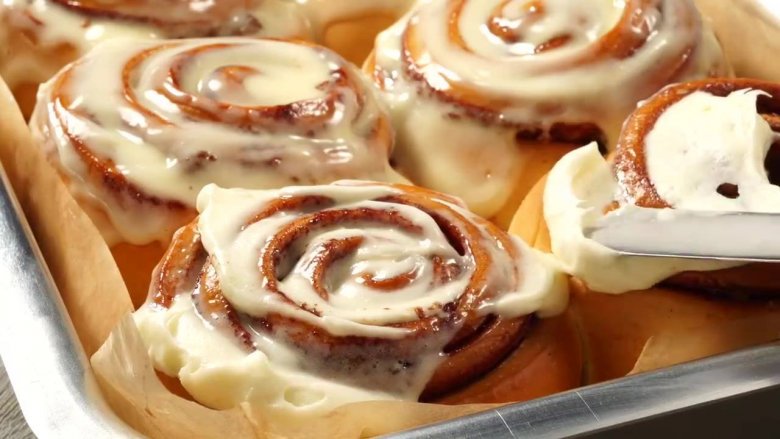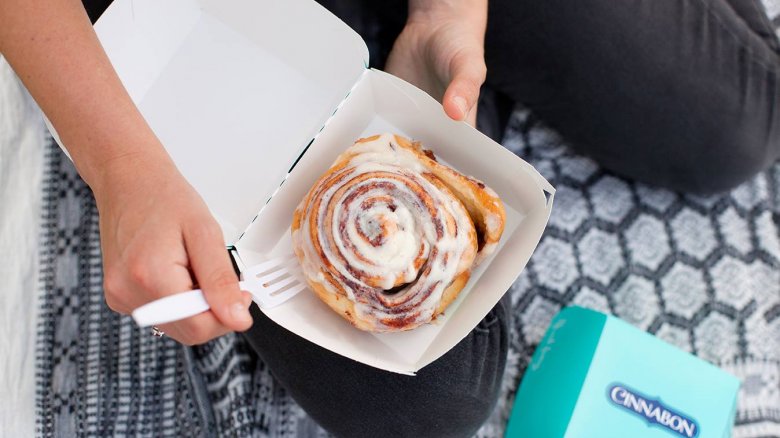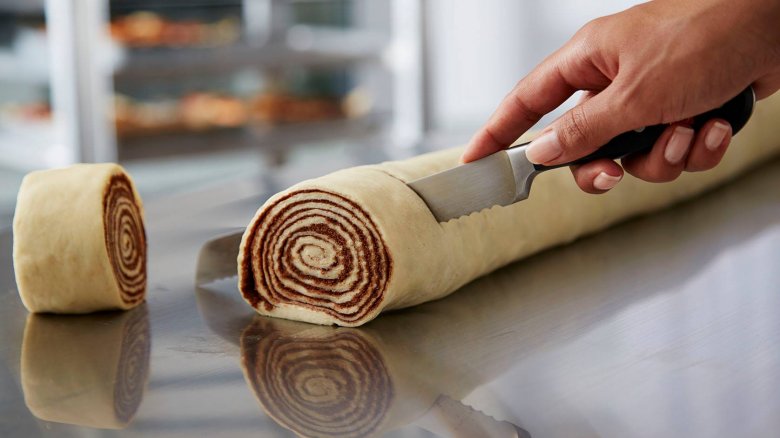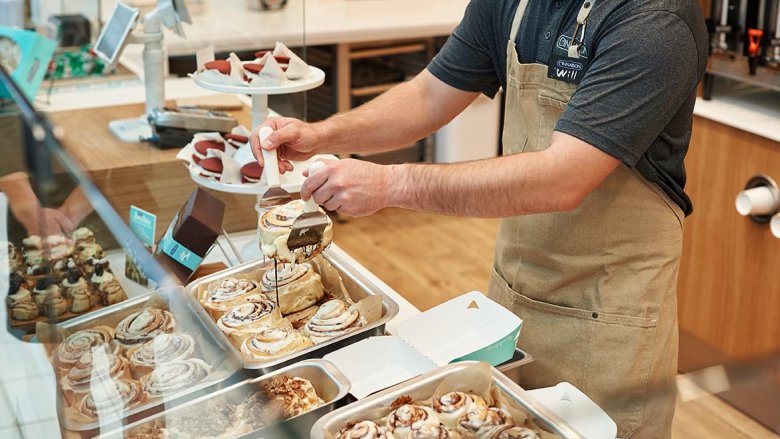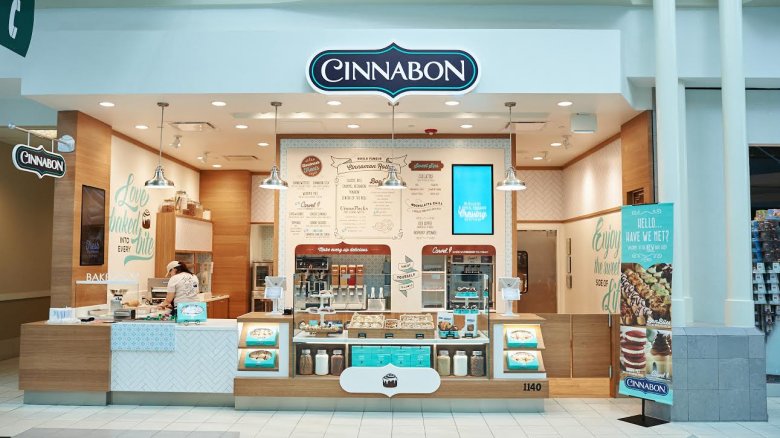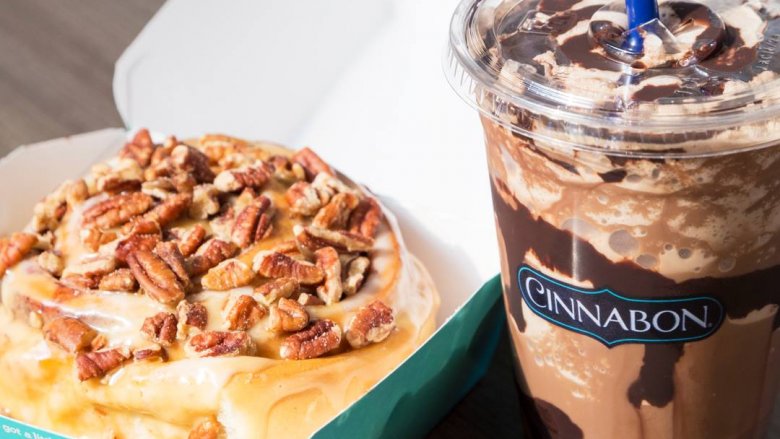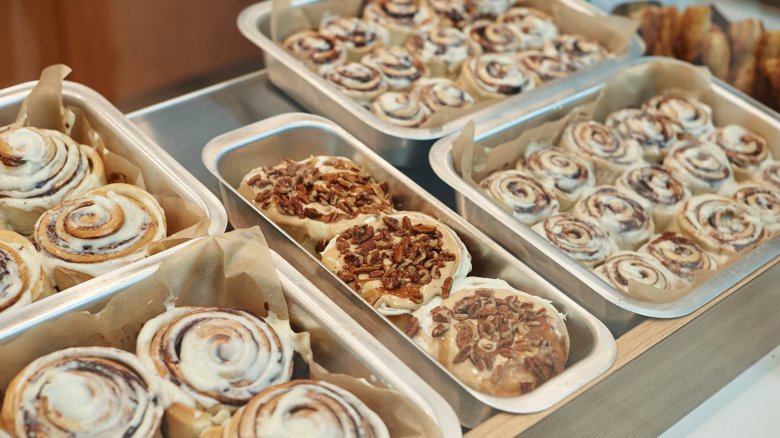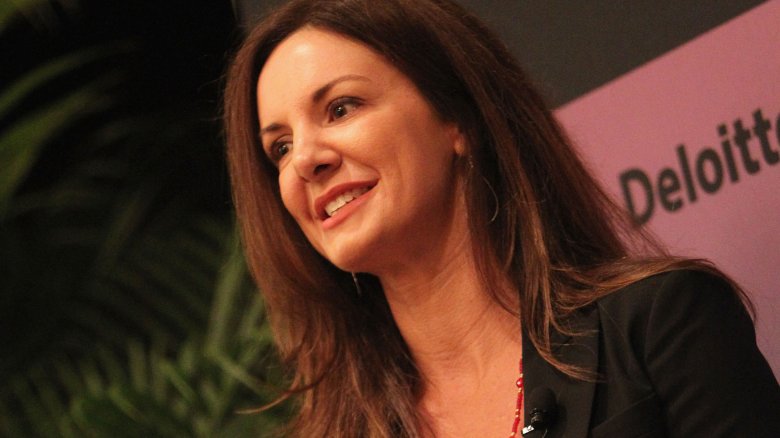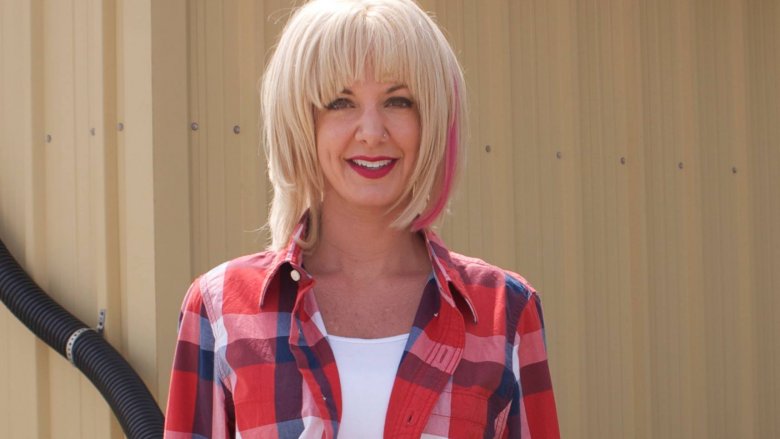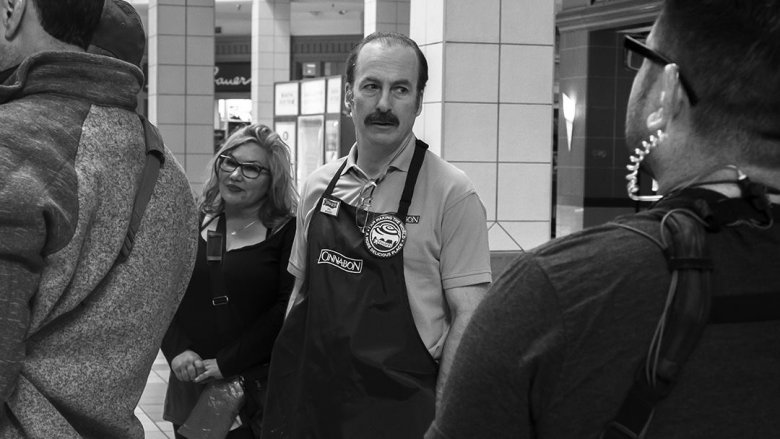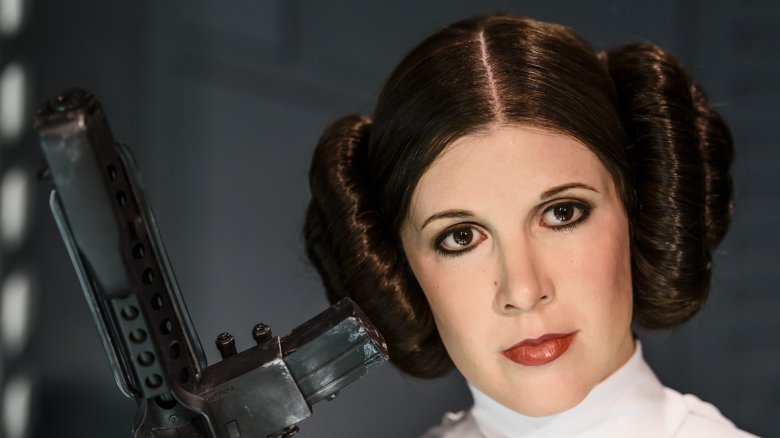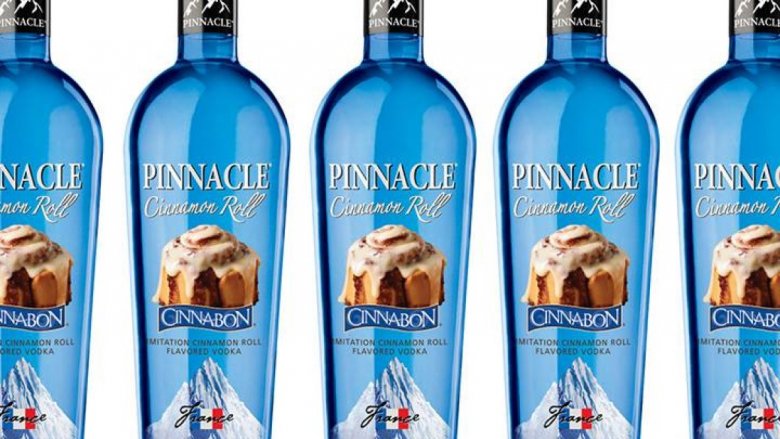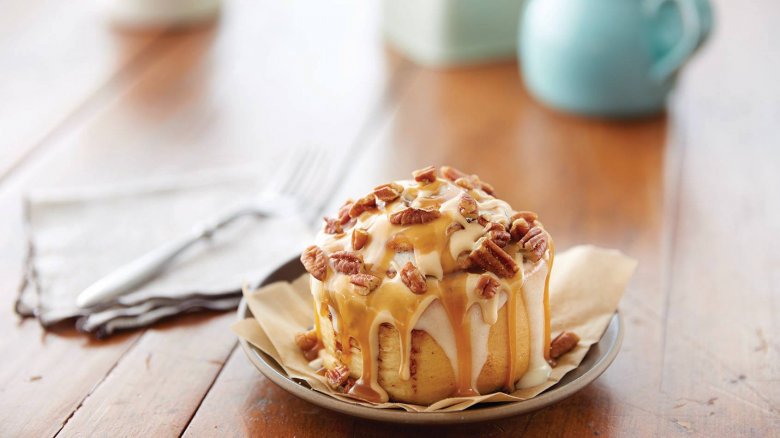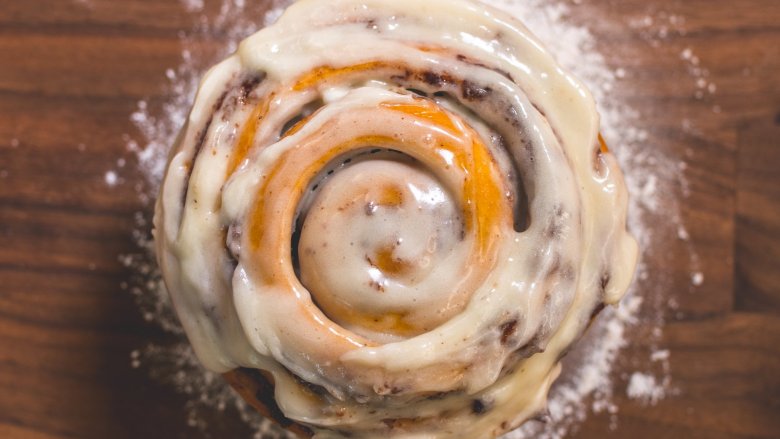The Untold Truth Of Cinnabon
Cinnabon is perhaps the most unlikely success story in fast food. They're built on one thing — cinnamon rolls — and sure, cinnamon rolls are delicious, but they're also very, very specific. According to Cinnabon's official history, the father-and-son team who originally founded the chain knew they had a winning idea when they first tasted their perfect cinnamon roll recipe, and they were right.
Cinnabon opened on December 4, 1985, in Seattle's SeaTac Mall. In just a few relatively short decades, they've expanded to more than 50 countries all over the world, and they've added just a few more things to their product lines. The smell of a Cinnabon is unmistakable, and it's credited with not only luring customers through the door but keeping them coming back as well. Because sure, you might be able to make cinnamon rolls at home, but they're just not the same, are they? That's in part thanks to a few secret ingredients... and some other fascinating facts you probably don't know about this global sensation.
They sell how many calories' worth?
Cinnabon is almost mind-numbingly popular, so let's talk numbers.
According to their nutritional information, one of their Classic Rolls contains a whopping 880 calories (and 37 grams of fat). That's a lot of calories for one person... but how many rolls are people eating, anyway?
Eater says Thanksgiving is one of Cinnabon's busiest times of the year, partially because of all the travellers needing a bit of extra ooey, gooey comfort. Numbers are without a doubt probably helped by all those holiday shoppers heading out for the first deals of the season, and they're all teaming up to help Cinnabon sell 8,300 cinnamon rolls every hour during Thanksgiving week.
Do the math, and you'll find that works out to 7,304,000 calories each and every hour during that holiday weekend!
Expand that time frame out to the whole year, and the numbers get even crazier. In 2013, Cinnabon was selling around 100 million rolls a year (via Bloomberg). Fast forward to 2017, and Bon Appetit says that number skyrocketed to a whopping one billion rolls a year. That's a lot of fat and calories (and a lot of delicious cinnamon rolls).
That's no ordinary cinnamon
Try to replicate Cinnabon's buns at home with ordinary ingredients and you're going to fail. Why? Because — in part — because they use a super-special sort of cinnamon.
Bon Appetit says that from the very beginning, Cinnabon went above and beyond when it came to making the perfect roll. The process of developing their recipes included extensive testing of almost every single kind of cinnamon (and there are a lot). Finally, they settled on a very specific type of cinnamon grown only in the highest elevations of a specific region in Indonesia. That area — called Korintjie — produces a particularly strong version of cinnamon that Cinnabon has turned into a proprietary blend called Makara. It's less sweet than other cinnamons, it's delicious in even savory foods, and it's the same stuff they sell in jars in their stores.
Their special cinnamon is what's responsible for that smell, too. Makara is so strong that no, they don't have to actually pump the smell of their cinnamon rolls through the air vents, like many claim.
It's all about the smell
There's no smell that's better or more mouth-watering than baking pastries, and Cinnabon has used that to their advantage. They may not pipe it into surrounding areas, but they don't leave it all up to chance, either. According to the Wall Street Journal, they maximize the scent with a few tricks. Cinnabon opens their stores in a ton of airports and malls, and that helps keep that smell contained and drifting through corridors to get stomachs rumbling long before people get to the store. Ovens are at the front of the stores, and according to president Kat Cole, sales significantly dropped in stores where the layouts were switched to put the ovens at the back.
They even tell franchisees to invest in the least-effective hoods they can legally get away with, just to keep more of that smell from being wafted away.
It might seem like everyone loves the smell, but it's actually caused some problems for them. Some buildings have what's called "aroma restrictions" in place, and buildings can be so strict about the scents their tenants release into their building that it's limited the places Cinnabon can actually open.
It happened because of a failed franchising deal
Love Cinnabon? You can sort of thank TJ Cinnamon's. Never heard of them? Here's why.
In 1984, restaurateur Rich Komen got a tip about a mobile bakery that had set up their first real counterspace in Kansas City's Ward Parkway Shopping Center. The shop was called TJ Cinnamon's, and they did one thing and they did it well: they made giant cinnamon rolls. People were lined up for them when Komen got there, and he approached them with an offer to franchise their concept. They originally agreed to allow him to open a branch of TJ Cinnamon's in Washington, says Seattle Met, but the franchise agreement fell through when he wanted to take them to the West Coast.
Komen had already leased a location, and suddenly had an empty building, no franchise, no recipes, and an agreement with the SeaTac Mall that said he was legally bound to open a cinnamon roll sales counter. So he went back to Square One, decided to take the concept, and build up his own brand. Cinnabon was officially born.
Why it's not called "Cinnabun"
Not calling the chain "Cinnabun" seems like a bit of a missed opportunity, but according to Seattle Met, there was a fascinating bit of logic behind the decision.
Komen and the man behind his branding, Terry Heckler, absolutely didn't want "bun" in the name of his chain for several reasons. One was simply the culinary connotation. A "bun" as he thought of it sounded too savory, more associated with the dinner rolls you get alongside a hunk of steak. It definitely didn't create images of the super-sweet, super-decadent desserts he wanted to sell, and it didn't help that there's other connotations to buns, too. The word is used to reference everything from body parts to babies, and it just didn't fit.
So where did "bon" come from? Koman was inspired by another dessert, the bonbon. It also helped that "bon" simply means "good" in French, and it just goes to show that when you start out thinking about international appeal, you just might get it.
Hundreds of recipes were tested
To create the perfect cinnamon roll recipe, Rich Komen called Jerilyn Brusseau, chef and owner of a restaurant just outside Seattle. She was already known for her cinnamon rolls, made from a recipe handed down to her from her grandmother.
Her original recipe is not the recipe they ultimately developed and decided on, though. According to Washington State's history on Cinnabon, more than 200 different recipes were tested before they settled on the one that made them famous. The difficulty came in meeting Komen's criteria: customers had to think they were worth their original price point of $1.25 (but they still needed to make a profit), and they needed to bake in no more than 14 minutes. That's a long way away from the original recipe's 30-minute bake time, and that's not an easy adjustment.
Brusseau told Seattle Met "I learned to fail exceedingly well," as she worked alongside Komen's son, Greg, to create a cinnamon roll the elder Komen would approve of. When they swapped the cinnamon to Makara and started taking out the rolls before they hit 190 degrees, they perfected the recipe. It was only two weeks before opening.
Their president started as a Hooters girl
In recent years, Cinnabon's massive growth has been led by someone shockingly young: Kat Cole, who was only 35 years old when she accepted a position as president of Cinnabon.
Cole got her start as a Hooters' Girl, and worked there through high school to help support her family. It kicked off a career almost everyone can be envious of. Skipping right over college, she ended up moving up through the ranks of Hooters to become an executive vice president at just 26 years old. Entrepreneur says when she took on her role at Cinnabon, it came with some serious challenges that included establishing overseas expansion projects in countries where cultural beliefs denied women — especially young women — had any place in positions of authority.
According to Nation's Restaurant News, Cole was at the helm during a massive period of growth for Cinnabon, and oversaw some major developments: licensing their products to other partners (like Burger King and Taco Bell), co-branding with grocery store items, and new locations for franchisees.
Undercover Boss
Anyone who's watched any reality TV has to wonder just how much lives change after appearances on network television, and when Kat Cole donned a wig, adopted a pseudonym, and went on Undercover Boss for Cinnabon, lives definitely changed.
Miguel DiCostanzo was a manager at one of the stores she visited, and was told that "Alexa Jones" had a rough start to life and was competing to win her own franchise. Cole was so impressed with him that when they flew him out to Los Angeles, he found he was the one being given his own franchise and $250,000 worth of start-up capital. According to NJ, his new location was even fast-tracked to make sure he was able to get the doors open before the always-busy Thanksgiving week.
When Entrepreneur talked to him a year later, he was still at the head of his franchise and ever-so-grateful for the continued support he got not only from Cinnabon's operations team, but the continued interest and advice he received from Cole herself.
Bob Odenkirk really did learn to make those buns
In what might be the oddest bit of product placement ever, a mention of Cinnabon during an episode of Breaking Bad took on a life of its own. When Bob Odenkirk's Saul Goodman got his own spin-off, Better Call Saul, audiences got to see his "best-case scenario": "I'm managing a Cinnabon in Omaha."
It might seem like it's a setting Cinnabon wouldn't really want to be associated with, but according to Quartz, they leapt on board. Cinnabon made sure they were being represented right, and Odenkirk met with Cinnabon executives to get actual training on how to make the rolls. He told The New York Times: "I'm telling you, Cinnabon is not about skimping on any ingredients. They weigh everything out, but I think they also put extra in. They are unabashedly putting everything your mouth loves into one hot lump — and they make no bones about it. So don't skimp on the frosting."
While Cinnabon had nothing to do with the original line in Breaking Bad, they have officially partnered with Better Call Saul for what has to be the strangest shout-out in marketing history. Ever.
Marketing gone wrong
Not all Cinnabon's marketing steps have been successful ones, and in 2016 they got a massive amount of hate on social media after posting their tribute to Carrie Fisher. After Fisher's passing, they tweeted a photo of Princess Leia, drawn in cinnamon, with a Cinnabon roll replacing her iconic hairstyle. The caption read: "RIP Carrie Fisher, you'll always have the best buns in the galaxy."
The tweet was removed, but the internet never forgets. The backlash was immediate, with social media condemning Cinnabon for using her death to advertise their cinnamon rolls. They apologized, saying it was "meant as a tribute" and they were "truly sorry."
Here's the weirdest thing: CNBC says they had actually used the same exact picture just months before. They posted it — also on Twitter — on May 4, 2016, for Star Wars Day, when they called her "the princess with the second-best rolls in the galaxy."
How Cinnabon vodka became a thing
Can't get enough of that Cinnabon flavor? Always wanted to put it into a boozy hot chocolate? You're in luck, because as part of Kat Cole's brand expansion, Cinnabon broke into the liquor market with Pinnacle and their Cinnabon-flavored vodka.
Buzzfeed interviewed Cole about the partnership, and says Pinnacle actually approached her with the idea. She tentatively got on board, with the caveat that they had to get it exactly right.
They did, she says, but only after 15 attempts. It wasn't that far of a stretch to get there, in the end, and Cole told them, "I wouldn't have predicted a year ago we would end up in the spirits world. I'm not shocked, but I really couldn't have predicted it."
So. Let's talk about the obvious: dosing a Cinnabon cinnamon roll with some vodka. Forbes did it, and called it a "booze-saturated gut-bomb." But hey, you're an adult, you can make your own choices.
How they grew with the "hotshot" rule
The Business Journals talked to Cole in 2015, and asked her what the secret was to her success and — ultimately — Cinnabon's growth. She answered candidly, and shared the method that helped build Cinnabon. She called it the "hotshot rule."
Every quarter, Cole says she would take an honest, unflinching look at everything she was doing through this lens: "Let's say a hotshot takes over my job today. What two or three things would the hotshot look at and say, 'That's unacceptable?'"
Cole says that it resulted in some long, hard conversations with the owners of some franchises that weren't performing as well as they should have been, and it drove her to book some flights and meet with the owners face-to-face. One of the franchisees left, while the other made the changes they agreed on and ended up involved in even more locations. Tough love, maybe, but it helped Cinnabon grow to a $1 billion company.
The Cinnabon secret
It's mind-blowing, to think of the level of Cinnabon's success. It's doubly impressive when you remember it was all built on the cinnamon roll, and if you're wondering if there's more to it, there is.
Only... no one knows what that is.
Kiro Radio sat down with Jerilyn Brusseau (and yes, they were treated to cinnamon rolls). She talked about the almost endless batches of cinnamon rolls they made in search of the perfect recipe, and remembered sitting in Komen's car, tasting cinnamon rolls, and trying to figure out what was missing from the operation.
She reminisced: "He said, 'What do you think it is? What's keeping us from succeeding?' I started thinking about my grandmother. What would she have done? And the big idea came, and that was the day. That's Cinnabon's secret!"
Brusseau refused to reveal just what the secret was, but she did give some hints about what it wasn't. She spoke freely about the special kind of cinnamon, so that's not it... what sort of inspiration did she find? The world might never know, but they can definitely take advantage of the results.
